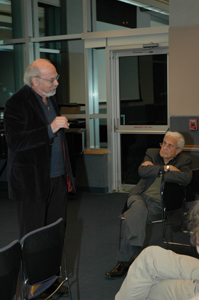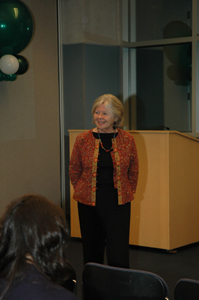- About Ramapo
- Academics
- Admissions & Aid
- Student Life
- Athletics
- Alumni
- Arts & Community
- Quick Links
- Apply
- Visit
- Give
Indian Nobel Laureate Rabindranath Tagore’s Relationship with German-jewish Luminaries and Pioneering Work on Education and the Environment Discussed at Ramapo College of New Jersey
(PDF) (DOC) (JPG)November 7, 2011
(MAHWAH, NJ) – In conjunction with the Asia Society’s exhibition, Rabindranath Tagore: The Last Harvest and to commemorate the 150th anniversary of his birth, the Center for Holocaust and Genocide Studies sponsored two talks on the Indian Nobel Laureate’s unique contributions and engagement with world culture.
The first lecture at Ramapo College was given on November 7 by Dr. Paul Mendes-Flohr, Professor of Modern Jewish Thought in the Divinity School of the University of Chicago and Professor Emeritus of Jewish Thought in the Hebrew University, Jerusalem. He discussed “A Transnational Fascination: the Indian Nobel Prize Winning Writer Rabindranath Tagore in Discourse with Albert Einstein and Martin Buber.”
As Professor Mendes-Flohr explained, Tagore first made the acquaintance of the Jewish philosopher Martin Buber during his 1921 visit to Germany. Immediately, it became apparent to both men that they had much in common, especially in their humanistic approaches to education and national identity. For his part, all of his adult life Buber had an abiding interest in oriental philosophy and religion. Thus, it was not surprising that, according to Mendes-Flohr, Buber “found Tagore a kindred soul.” As indicated above, inclusivity and co-existence characterized their attitudes towards national identity. However, it was in their predilection for student-centered and experientially oriented education that there was a true meeting of the minds.
More problematic, according to Mendes-Flohr, was Tagore’s relationship with the German-Jewish physicist and fellow Nobel laureate Albert Einstein, whom he first met on a 1926 visit to Germany. In 1930 and 1931, during three subsequent meetings at Einstein’s summer home outside Berlin, their relationship intensified. Although the two men shared a sense of being part of an international community of philosophers and scholars and had a common belief in a universal human ideal, as Mendes-Flohr explained, they were polar opposites in some respects. Tagore believed that the natural world could only be seen in terms of our “mental constructions,” while Einstein held the view that there is an independent “order to nature” that physics can determine. Yet the considerably younger Einstein deeply admired Tagore and wrote a moving and heartfelt contribution for Tagore’s 70th birthday volume, The Golden Book of Tagore. Conversely, Tagore wrote admiringly about Einstein. They both also shared in common a love of music.
A similar chord on Tagore’s emphasis on practical experience and the respect for the student was struck by Dr. Kathleen O’Connell of the University of Toronto in her lecture of November 10, 2011. Entitled “Rabindranath Tagore; the Poet as Educator and Environmentalist,” her talk stressed how Tagore in everything he did embodied an integrated conception of human culture that encompassed the physical world as well as the interior life of the individual.
As O’Connell explained, Tagore was by no means just a theorist on education. At Santiniketan, he established a school that eventually blossomed into a university and a community that was deeply rooted in pleasurable learning individualized to the personality of the child and revolved organically around nature. Classes were held in the open air under the trees (which he had planted) to provide for a spontaneous appreciation of the fluidity of the plant and animal kingdoms, and seasonal changes. In her richly illustrated presentation, O’Connell also pointed to Tagore’s pioneering efforts in global cultural exchange, mixed sex education, and establishing a religiously diverse student body. Also groundbreaking, according to O’Connell, were the measures he introduced to create a more livable and sustainable environment in West Bengal. These included the planting of trees and the introduction of sound plowing methods. Professor O’Connell hopes that Tagore’s timeless educational philosophy and environmental practices will become more widely known and appreciated as the world celebrates the 150th anniversary of his birth.
The presentations of Professors Mendes-Flohr and O’Connell were made possible with the assistance of the Asia Society, New York.
On view at the Asia Society Museum in Manhattan through December 31, 2011, the Asia Society’s exhibition, Rabindranath Tagore: The Last Harvest showed more than 60 works on paper, drawn from three collections in India, many of which have never been seen in the United States. This exhibition provided U.S. audiences with a unique opportunity to appreciate Tagore’s substantial artistic legacy.

Dr. Paul Mendes-Flohr

Dr. Kathleen O’Connell
E-News Archives
| 2023 | 2022 | 2021 | 2019 | 2018 | 2017 | 2016 | 2015 | 2014 | 2013 | 2012 | 2011 | 2010 | 2009 | 2008 | 2007 |Copyright ©2025 Ramapo College Of New Jersey. Statements And Policies. Contact Webmaster.

Follow Us!